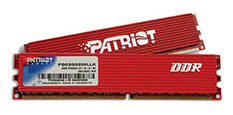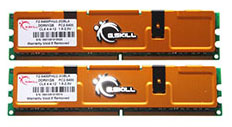Pre-AM2 Mid-Range Buyers' Guide, May 2006
by Jarred Walton on May 9, 2006 6:30 AM EST- Posted in
- Guides
Memory Recommendations
While we wait for AMD socket AM2 to launch, we still need to have separate memory recommendations for AMD and Intel systems. Just as I'm done recommending single core processors for midrange computers, I'm upgrading both systems to 2GB of RAM. If you're running a dual core processor and doing a lot of multitasking, the extra memory will definitely come in handy. Prices have also dropped to the point where even good quality 2GB kits don't cost that much. It was about 18 months ago that we stopped recommending 512MB configurations for midrange computers, which means it's about the right time to bump up to the next level of memory. Hopefully, in another 18 months we will be able to recommend 4GB of RAM for less than $200. |
| Click to enlarge |
DDR Memory: Patriot PC-3200 2x1024MB EPLL (2-3-2-5-1T)
Price: $190 shipped (Retail) - $55 Mail-In Rebate until 5/15/2006
Choosing a 2GB kit of DDR memory was actually relatively easy. There are kits out there that will overclock higher (without using lower memory ratios), but the majority of them cost quite a bit more. There are also a lot of mail-in rebates currently available for DDR memory, most likely due to the pending launch of AM2. This Patriot memory comes with the lowest timings you can find on any DDR 1GB DIMM, and it also happens to be one of the cheapest 1GB DIMMs available. My experience is that you can push the memory up to around DDR-450 with relaxed timings, so combined with the memory ratios on AMD motherboards you can still achieve good overclocks. If you're willing to spend a bit more money, Corsair, OCZ, G.Skill, Kingston, and Crucial are all reasonable alternatives - and potentially cheaper, depending on whether or not you take advantage of the mail-in rebate.
 |
| Click to enlarge |
DDR2 Memory: G.Skill PC-5300 2x1024MB Extreme LA (4-4-4-12)
Price: $148 shipped (Retail)
Moving to the DDR2 recommendation, there are thankfully no mail-in rebates to worry about. Balancing maximum bandwidth against latency and price, DDR2-667 looks to be the sweet spot. The G.Skill memory offers reasonable timings of 4-4-4 at that setting, and the price is only about $15 more than DDR2-533. A quick glance at the DDR price shows that without mail-in rebates, DDR2 definitely has the advantage, and a higher potential bandwidth doesn't hurt either. If you're thinking about DDR2 memory for the new socket AM2 platform, you might want to upgrade to DDR2-800 memory. That will bump the price up to $220 or more, but for Intel platforms we don't feel it's truly necessary (except for the extreme performance people that are buying $1000 P4XE processors). Should you spend the extra money right now to upgrade to DDR2-800, so that you can take it over to your AM2 platform in the future? Personally, I would say no - you can just sell off your current system and buy new memory if you upgrade motherboards and processors in the future. Six months from now, there will almost certainly be better DDR2 memory available anyway.










56 Comments
View All Comments
ZJB298 - Wednesday, May 17, 2006 - link
K, so I'm a huge newb, but what's the point of getting or switching to X16 over X8 if there is no performance impact? Is there likely to be more of a performance impact for a gamer or a higher-end graphics card than for a normal user?Basically, is it worth it for me to go searching for another, more expensive motherboard with X16 slots over X8 slots?
JarredWalton - Saturday, May 20, 2006 - link
In my opinion, NO! Dual X16 is just a lot of marketing hype. The board that sport it might benchmark faster at times (by 5% or so), but 5% can be had through BIOS optimizations.Crassus - Tuesday, May 9, 2006 - link
Thanks for a new Buyer's Guide. I wondered when the next one would come for quite some time. It maybe not necessary to bring them as often as when they started, but right now I think they're spaced a wee bit too far apart.It's always a very helpful read and I use it not only as a recommendation of what to buy, but also as an indication of where the industry stands at this time, i.e. what the standard is for any given component. Keep up the good work and (maybe) update them a little more often again.
sabrewulf - Tuesday, May 9, 2006 - link
"Plenty of people are still running old socket 478, 462, and 754 systems, and they're perfectly happy with the level of performance and they have. The latest and greatest computer games almost certainly wouldn't run on those older systems without drastically reducing the graphics quality"754 + PCI-E = perfectly capable of running with maximum eye-candy.
LoneWolf15 - Tuesday, May 9, 2006 - link
And the percentage of Socket 754 mainboards with PCI-E is?Socket 754 performance is decent, but it's truly a dead-end. For hard-core gamers, I'd urge them to get out while they can sell their parts for reasonable cost, much like I'd have said to Socket 423 owners when the P4 switched to 478.
JarredWalton - Tuesday, May 9, 2006 - link
Notice the "OLD" socket 754 part? Obviously, newer 754 PCIe boards are okay. LOL I still do a ton of work on my 754 + 6800GT system, though.sabrewulf - Friday, May 12, 2006 - link
Sorry I guess I didn't notice that word. I'm mostly just speaking up for people like my brother who last year wanted to upgrade his graphics card, but already has a 2.4 ghz 754 chip and couldn't afford a new video card AND an equivalent 939 CPU at the same time, so he got a cheap solid 754 PCI-E board instead. Works great for him, and with AM2 right around the corner, it looks like an even smarter purchase since he can pretty much skip 939 altogether.LoneWolf15 - Tuesday, May 9, 2006 - link
The thought of Socket AM2 didn't excite me, but not just because of the lack of performance. So I think this Upgrade Guide makes a lot of sense (well, at least if you don't need to do a mainboard upgrade at present time).Just the thought of having to completely reload Windows XP was enough to cause me (a month ago) to decide it was better to upgrade to 2GB of DDR and go from a Winchester 3000+ to an Athlon 64 X2 3800+, with no mainboard swap required. My MSI Neo 4 Platinum has been a good board. I plan on getting one year more at the very least out of it before I consider the new platform. I'm sure AM2 is the best option for anyone who still has an Athlon XP (unless they don't wish to save by not swapping out RAM) and that waiting for new Intel hardware is the best solution for anyone who currently has a Socket 478 system or earlier, but now that I have a system board I'm completely happy with, it's really hard to justify an upgrade that would require me to gut the OS...I no longer have that kind of time on a regular basis.
APKasten - Tuesday, May 9, 2006 - link
I find it really hard to believe that 1GB of PC3200, even at low latencies, is worth almost $200. I can get 2 GB at higher latency (4-4-4-7) for about $150! Is the performance boost really worth that much money for just 1 GB? I was always under the impression that more RAM was better than having extra low latency RAM.I took AnandTech's recommendation to get the OCZ EL 512MB (2x256MB) Kit (2.5-3-2-6?) a few years ago. I replaced that with a GeIL 1 GB (2x512MB) kit at 4-4-4-7 last year and I have since had much better performance from my system. That was the only thing I changed on my box. So I guess my real question is, wouldn't 2 GB at higher latencies be better than 1 GB at lower latencies, bang-for-buck-wise?
APKasten - Tuesday, May 9, 2006 - link
Holy crap. Nevermind...I just realized that it was a 2GB kit you were talking about in the article.Sorry. *rolls eyes*